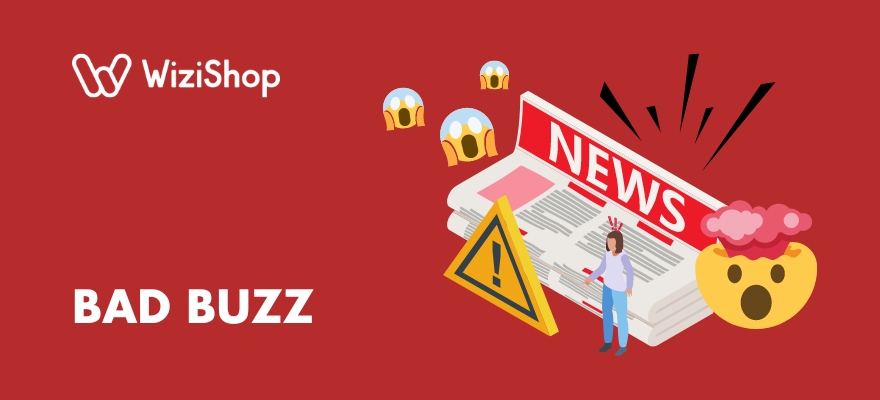Advertising and communication are two important pillars for any business. Brand image, branding, loyalty, storytelling...So many elements are concentrated in these two fields in order to highlight a brand, service, or products, to make them known, to announce a release to users, or simply to ensure a presence on the market.
The stakes are enormous when it comes to speaking to the public, whether it’s through media channels or a social network. Finding the balance between “selling,” “making people dream,” and “telling the truth” becomes a headache. Getting help from an agency or professionals is often beneficial to prevent any risk.
But when the message built around an offer or an entity is misdirected, how does it translate? When a not-so-great action is made known, how should you react to the criticism?
When bad buzz sets in, there are many reaction levers. No one wants to see their business criticized, or even boycotted in the worst case.
So, let’s see how to avoid the worst with a few examples that have made history in marketing!
Bad buzz: Definition and characteristics
On the web, on television, on a social network, around customer data, sales of certain products on the internet, the behavior of certain employees...Bad buzz can take several forms and affect several levels of brands or companies. Above all, though, it can put the entity and its employees in a bad position. Let’s try to understand what this situation involves and what it generates.
What does it mean to make a buzz?
Making or creating a buzz in marketing refers to generating widespread excitement, interest, and conversation about a product, service, or campaign. This often involves using outrageous marketing, creating viral content, leveraging social media, and engaging influencers to capture attention quickly.
The goal is to create a strong word-of-mouth effect, where people eagerly share and discuss the marketing message, amplifying its reach and impact. A successful buzz can significantly boost brand awareness, drive sales, and enhance a brand's reputation.
How do you define bad buzz?
The term “bad buzz” designates a type of scandal, defined by the fact of receiving negative comments following an action made known and linked, closely or remotely, to a company, an institution, or a person.
A kind of negative “word of mouth,” this phenomenon can be linked to an advertisement, an internal announcement, or the actions of one of the members of an organization for example.
Over time, the triggers of these alerts related to the negative actions of brands and their effects on the company have evolved, from traditional media to the internet. With the importance of social networks, the main lever of bad buzz today is found on these social platforms, on the side of internet users, where the customer has the floor.
Social networks: Consumers’ weapons
A few years ago, the customer used to meet other users on forums or a blog page to discuss news, give feedback, and review a product or service. Now, Twitter, Facebook, and Reddit have transformed the way people talk. “Word of mouth” is becoming viral thanks to the internet and social networks.
Instagram has also become a means of communication but also of denouncing certain corporate practices.
Accounts such as @diet_prada, @thefashionlaw, @esteelaundry, and others are platforms reserved for exposing to the general public a kind of “hidden face” of international companies, negative actions within teams, or even misleading advertisements around products or services offered.
What is an example of bad buzz? Different types
- Reputation bad buzz: it calls into question the reliability of a brand, leading to a loss of confidence among buyers;
- Employee bad buzz: exposing abuses within a company's teams;
- Anti-change bad buzz: for a business that's resistant to a necessary transformation (policy, marketing, product, etc.);
- False-rumor bad buzz: a message intended to mislead the public, based on false information;
- Controversy bad buzz: information that goes from the company itself to a controversy or a scandal because of insulting or hateful content;
- Engagement bad buzz: information or actions that go against fundamental values or practices anchored in society;
- Plagiarism bad buzz: when a company is accused of having copied the creations or services of another;
- Green-washing bad buzz: when a business is accused of using arguments related to ecology and sustainable development to boost its brand image and hide other practices that are less than environmentally responsible.
10 Examples of bad buzz in marketing
Some advertising and marketing campaigns have made a name for themselves and raised consumers’ hackles. Indignation, anger, and even boycotts have affected the brands. Was it a mistake, negligence, a lie, or a controlled slip?
Despite the negative nature of the bad-buzz phenomenon, some brands have respected the adage that bad buzz is, above all, buzz.
For most of them, though, the consequences of these reputation crises have been catastrophic...Let’s take a look back at these controversies that have marked the history of marketing.
Bic
Bic, mostly known for its manufacturing of ballpoint pens, lighters, and razors, released their Bic Cristal “For Her” pens targeted toward women in 2012. The company described the set of pastel-colored pens as having features such as a “thin barrel to fit a woman’s hand” and an “elegant design – just for her!”
Shoppers on Amazon had a field day with the product, writing sarcastic reviews that called out BIC for creating such an overtly sexist product.
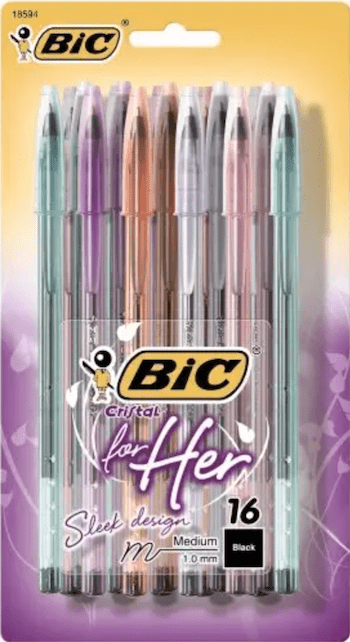
Chipotle
From July 2015 to January 2016, the American fast-casual chain specializing in made-to-order tacos and burritos dealt with E. coli outbreaks linked to restaurants in the northwestern US and spreading across multiple states.
After Chipotle wasn’t forthcoming to the general community regarding the severity of the issue for several months in addition to initially responding defensively when questioned about the problem, the company’s stock price targets took a dive.
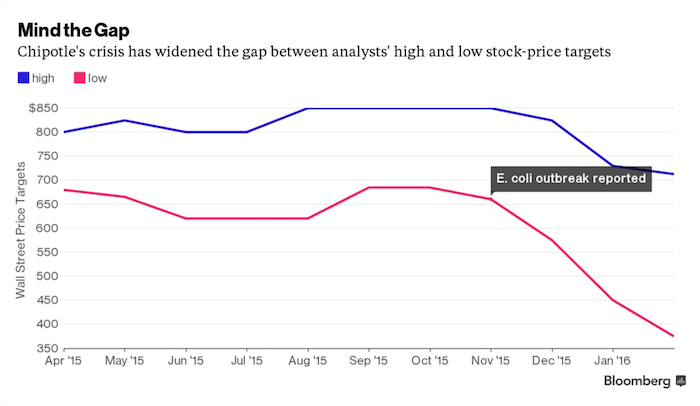
Source: Bloomberg
Volkswagen x Voltswagen
An April Fool's joke that was a little too serious. The car brand announced that it was changing its name in the United States to “Voltswagen,” in connection with its new electric models.
Taken seriously by the whole world, the American media relayed this information which then went viral. Despite the manufacturer's denial of the April Fool’s joke, the American Securities and Exchange Commission decided to open an investigation, turning the joke into a real corporate bad buzz!
Dolce & Gabbana
The Italian luxury brand wanted to celebrate its arrival in China with an advertising campaign. Unfortunately, the spot did not go down well with the Asian public.
Several short videos showed a young Chinese woman dressed in Dolce & Gabbana at the table, trying to eat Italian specialties with chopsticks.
These films were interpreted negatively in China and were removed very soon after their publication. Following this controversy, internet users found old tweets of one of the two founders against Chinese culture. The house was boycotted as soon as it arrived in China.
Tesla
The automotive giant unveiled its new electric car of the year 2019, “Cybertruck,” with windows advertised as being “virtually unbreakable.” During the presentation, Franz von Holzhausen, Tesla’s chief designer, threw a metal ball at the car to demonstrate its strength. Unfortunately, two of the car’s windows broke, and the experience showed that the supercar was not unbreakable.
Tesla CEO Elon Musk stated that the vehicle had performed successfully under similar testing just before the event, but the company’s stock dropped right after the live demo anyway.
Pepsi
It’s a product video that’s been talked about all around the world. The soda brand wanted to propose a campaign tinged with activism, featuring the international model Kendall Jenner in the heart of a demonstration “for peace.”
However, this video caused significant indignation: Internet users saw an appropriation of committed events, especially around the Black Lives Matter movement, for commercial purposes. Pepsi’s message missed the mark, and this spot has been engraved in the minds of viewers since 2017.
Findus
In 2013, the European scandal of "Horsegate" broke out around the horsemeat contained in dishes initially prepared with beef.
In the French market, it was determined that Findus lasagna contained 100% horse meat, a discovery that caused controversy in France.
With falling sales and a loss of consumer confidence, the food giant sought to remedy the crisis by adapting its communication around the fact that Findus was a “victim” of its suppliers and filed a complaint against them.
This scandal has forced Findus to question itself and to establish “transparency” in its communication around its products.
H&M Kids
The fast-fashion brand had internet users indignant with the presentation considered racist of one of its sweaters for children. The photograph made a world tour at its release before being removed from the catalog.
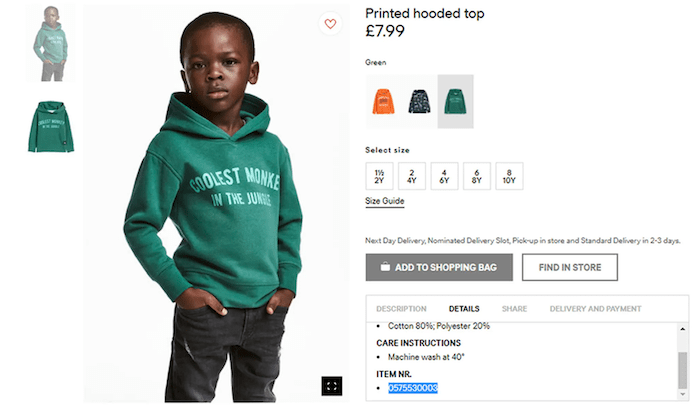
United Airlines
A video showing a passenger of an overbooked flight being taken out of the plane by force had made the rounds of the world.
Following this violent exit, the airline suffered not only the anger of internet users but also the consequences on its stock, that is to say -4% on the stock exchange, which then represented nearly one billion dollars. Mentions of the hashtag #unitedairlines and #boycottunited on Twitter, Facebook, Instagram, and Reddit exploded.
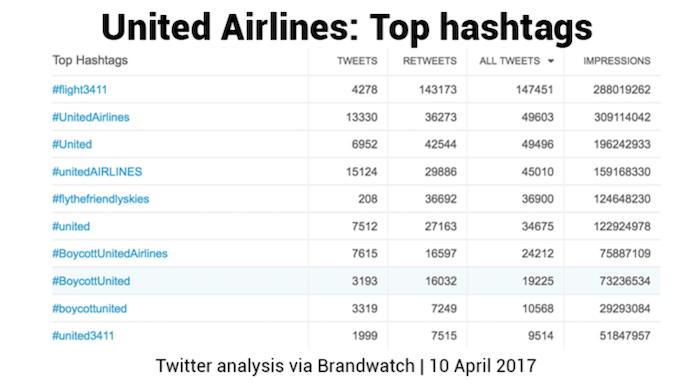
Source: Brandwatch
Burger King
On International Women's Day in 2021, Burger King UK posted a thread on X (formerly Twitter), starting with the controversial tweet: “Women belong in the kitchen.” This was followed by a second tweet clarifying, “If they want to, of course,” and a third tweet announcing a new scholarship program aimed at helping women pursue degrees in culinary arts to address the gender gap in the restaurant industry.
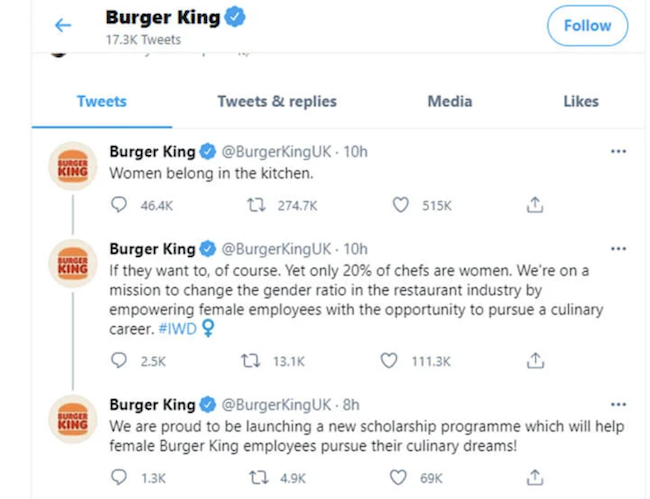
While the first tweet was meant to grab attention and the subsequent tweets were intended to be progressive, many Twitter users only saw the initial tweet, leading to a backlash over its seemingly sexist tone. Even those who viewed the entire thread found it to be a tone-deaf attempt to commemorate Women’s Day.
In response, Burger King deleted the thread and issued an apology, explaining their original intent.
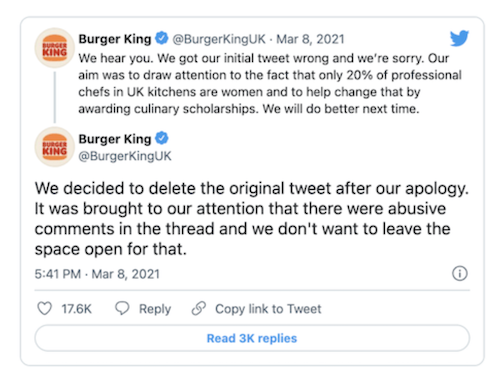
How do you prevent bad buzz?
With social networks, it’s the consumers who’ve taken over the power. In a short period of time, a reputation can be tarnished and some companies are forced to close down after internet users speak out. Preventing the worst from happening is possible, as long as you follow some central rules as you manage your ecommerce site and run your business.
Storytelling, yes, but no lies!
Your marketing strategy must be put together before you build your ecommerce website from scratch and launch your business. At the heart of this strategy is the image of your brand, which is then translated into various actions (external and internal communication, webmarketing actions, street marketing, etc.).
Obviously, you need to work on your central message to create a positive image of your company and your brand for your target audience, in order to succeed in attracting as many consumers as possible.
However, you should never confuse “storytelling” with “telling stories!” The truth often, if not always, comes out.
For instance, if your products aren’t created in France, don’t add “Made in France” to your logo. Moreover, these deceptive practices can cost you a lot of money in legal terms, after being boycotted by consumers...
Be transparent in your communication
The previous point is closely linked to the transparency you can use in your communication.
Don’t hide key information that could be useful. The more you remain “yourself,” the more you can use this honesty as a positive difference from your competition.
In addition, to encourage internet users to trust you, communicate as much as possible about your practices, your teams, your values, and your products, in order to include the consumer in the life of your online retail business.
Good management: The key to your longevity?
Increasingly aware of the issues related to well-being and respect in companies, the public wants to support companies in which employees are respected and valued.
The key to a business that lasts also lies in the treatment of its team.
Listening to your employees, being respectful, being ahead of the game, and knowing how to challenge yourself as a manager: all this is priceless.
Monitor your e-reputation
Social networks, reviews on platforms, forums, etc. are all pages that receive comments from internet users and buyers.
Despite all your efforts, some people may not have appreciated something about your products or business and may share them with the public via these platforms.
It’s up to you to monitor your online reputation, or e-reputation, to improve or to take care of possible complaints. If you find that your online store isn’t selling like you’d hoped,
Positive or negative, any comment is good to review: thanks to the Google Alerts tool, you can activate the search engine’s notifications to be aware of reviews and comments mentioning your brand name as they occur.
How should you react to bad buzz?
In business life, you may be confronted with a “bad buzz” experience, of varying severity. When this happens, it’s best to be prepared to react according to a precise plan.
Go into “crisis mode”
These episodes involving negative comments aren’t easy to handle. So, even before you know the beginning of a crisis related to a campaign or news item, prepare your arguments and your action plan. Think of phrases to suit the circumstances, a scenario adapted to each situation.
Preparing for difficulties also means anticipating future problems and being ready in all circumstances.
This preparation can also help you to be confident in your actions. It’s a kind of psychological conditioning and a position that you’ll adopt to react in the best way.
You’ll thus face obstacles with all your strength, not sinking into panic, which could be fatal for your business.
Silence, your worst enemy
The most famous examples have made us understand that silence has never served the causes of companies in times of crisis.
Passivity may be more comfortable, but it’s also more negative. Not reacting is a message of weakness to the public: be prepared to speak up, but with composure.
Take a step back and give yourself time to react
Don’t respond on the spot! If you get carried away by your emotions when dealing with the crisis, you risk putting your foot in it, and this won’t serve your business in any way.
Make sure you take a step back and give yourself the necessary distance to write a response that will allow you to prove your good faith, to apologize publicly, or to make it possible for users to discuss the issue calmly during a dedicated event...
This experience is demanding, which is why you can get assistance from a communication agency or somebody specialized in crisis communication.
“A mistake confessed is half forgiven?”
When speaking out, acknowledging your faults won’t harm the situation, on the contrary.
By listening to consumers and customers, taking a step towards them, and explaining your actions, you can improve the situation.
However, don’t expect to wipe the slate clean once the message is published. It’ll potentially take a while for the public to allow you to start over.
In any case, don’t deflect attention by pointing fingers at other individuals or entities: admitting your mistakes will provide the best outcome.
Be honest and prove it!
Finally, make sure you prove your desire to move forward, to improve by reporting on the changes you have made within your organization.
If words are the first step, actions will be your strength: communicate your new strategy, your new arguments, and your lessons learned from the past.
As we’ve seen, bad buzz isn’t—always—an inevitability, but it’s necessary to do everything possible to avoid it.
For many large and small companies and brands, this unpleasant episode is an opportunity to draw consequences around their actions, words, and communication.
Management, production, marketing, merchandising, etc. All of a company’s sectors are concerned and scrutinized by consumers looking for meaning in their purchases.
Public trust is earned after a long process, but it can be lost very quickly. To prevent any risk of slippage, calling on communication agencies could be an excellent initiative, provided that transparency, honesty, and respect are at the heart of your professional DNA.


